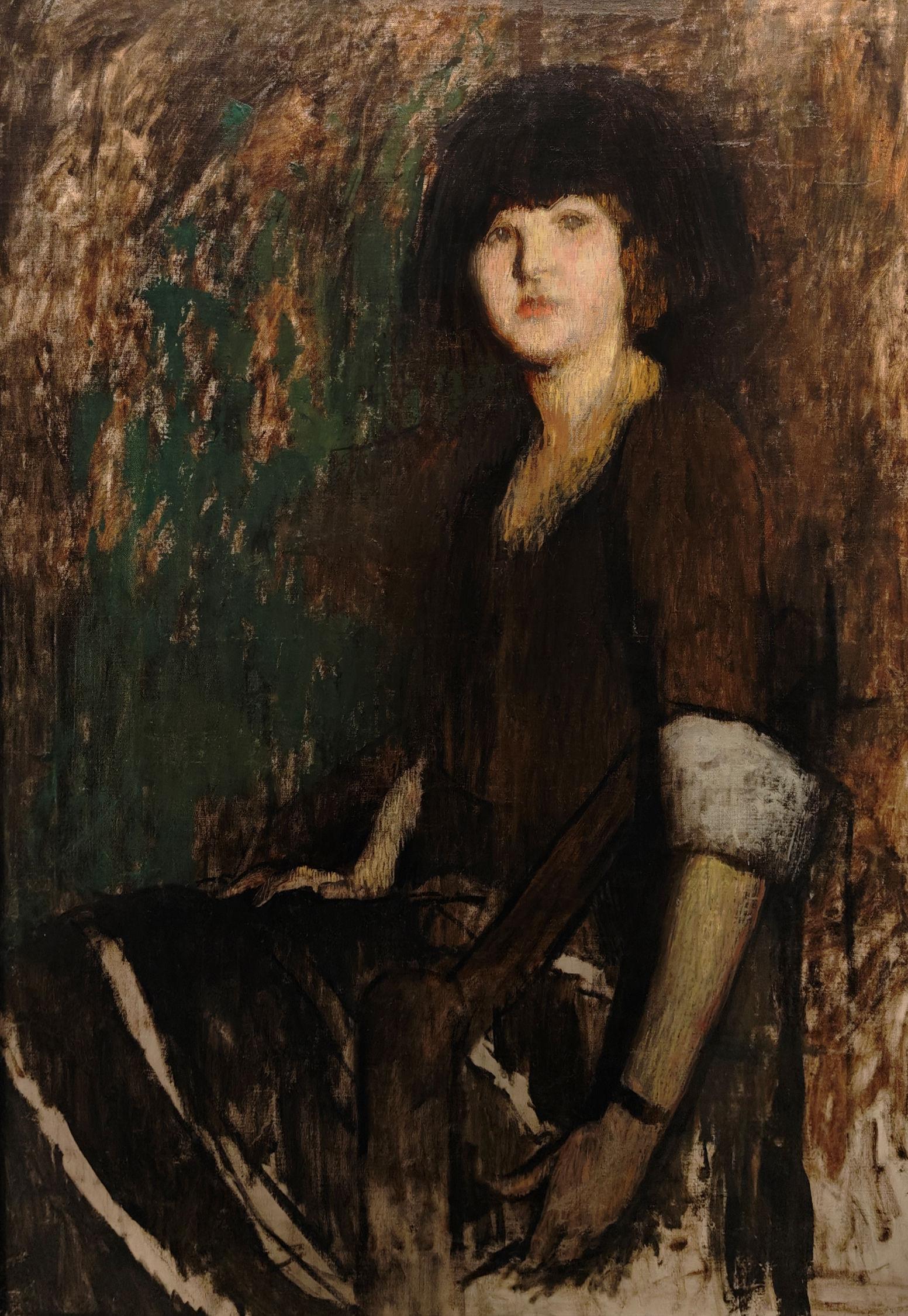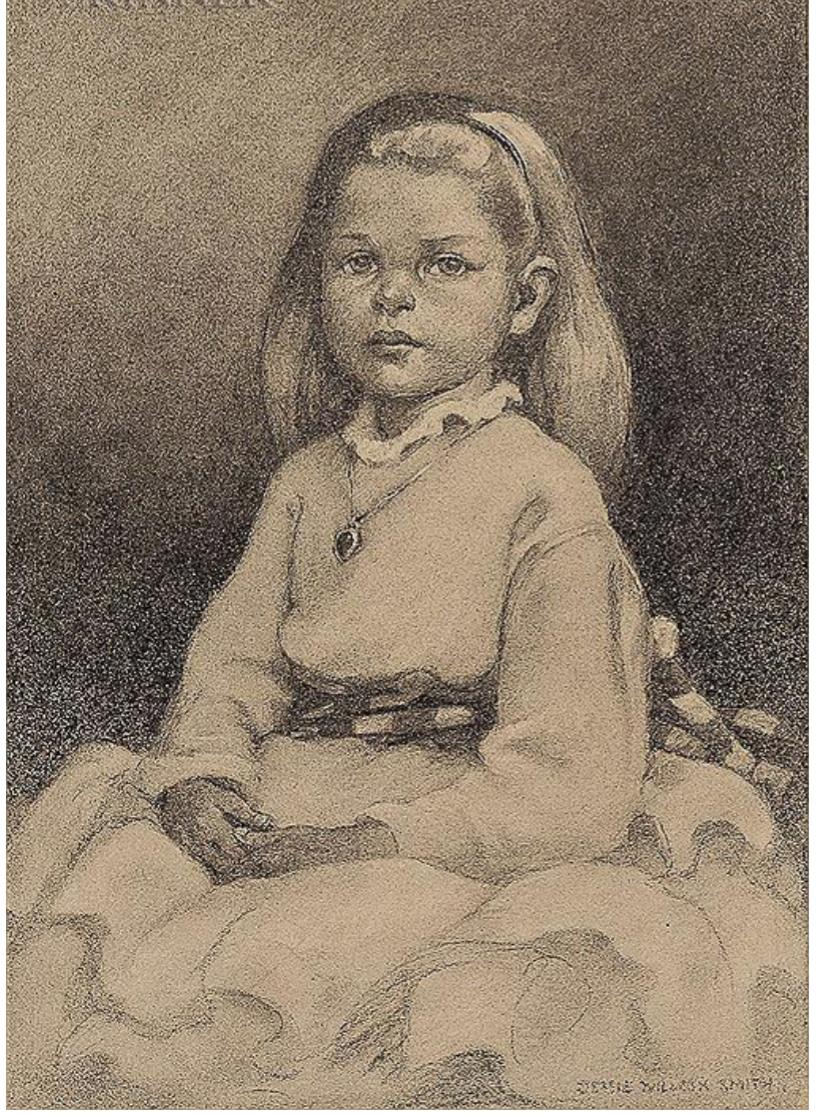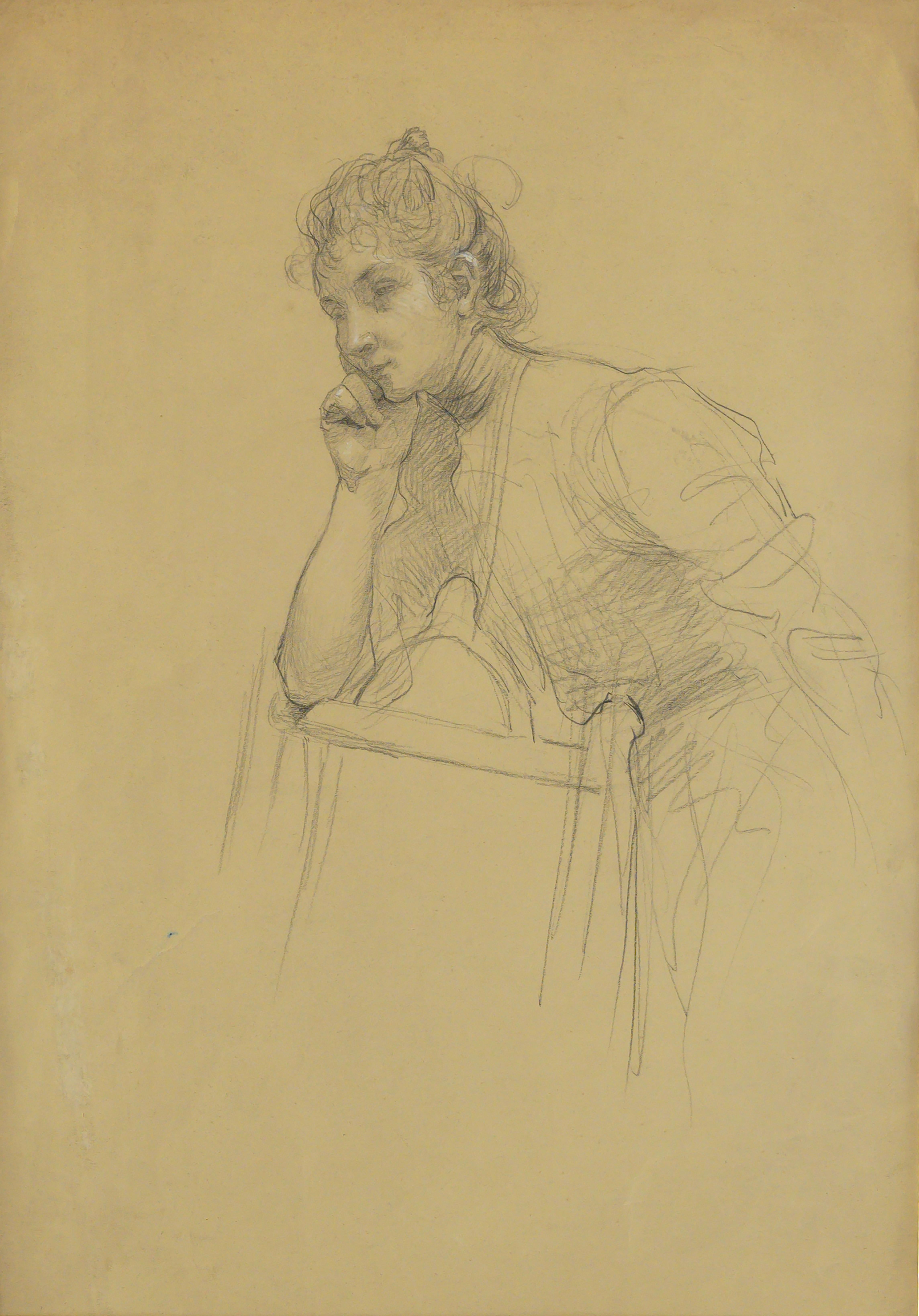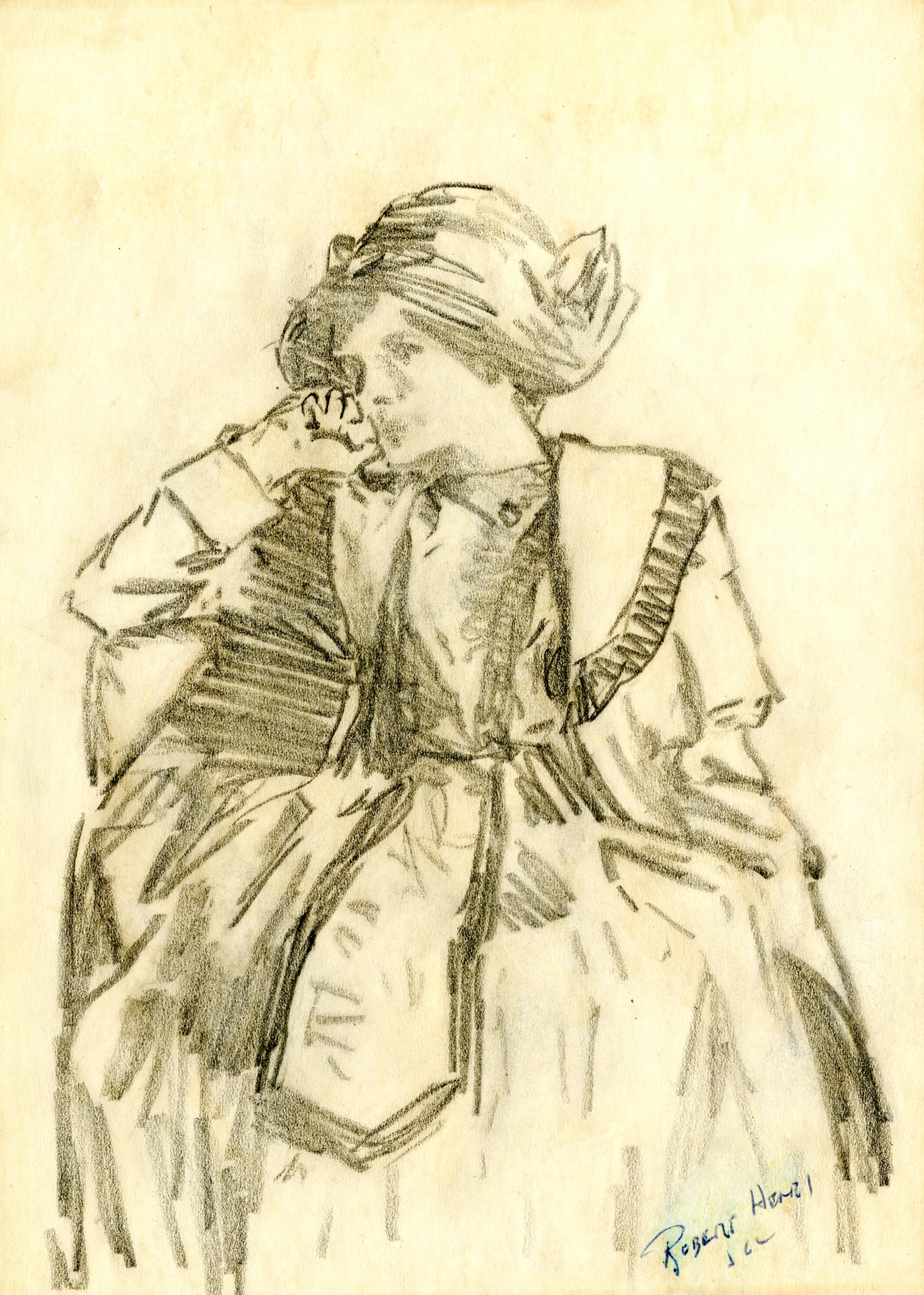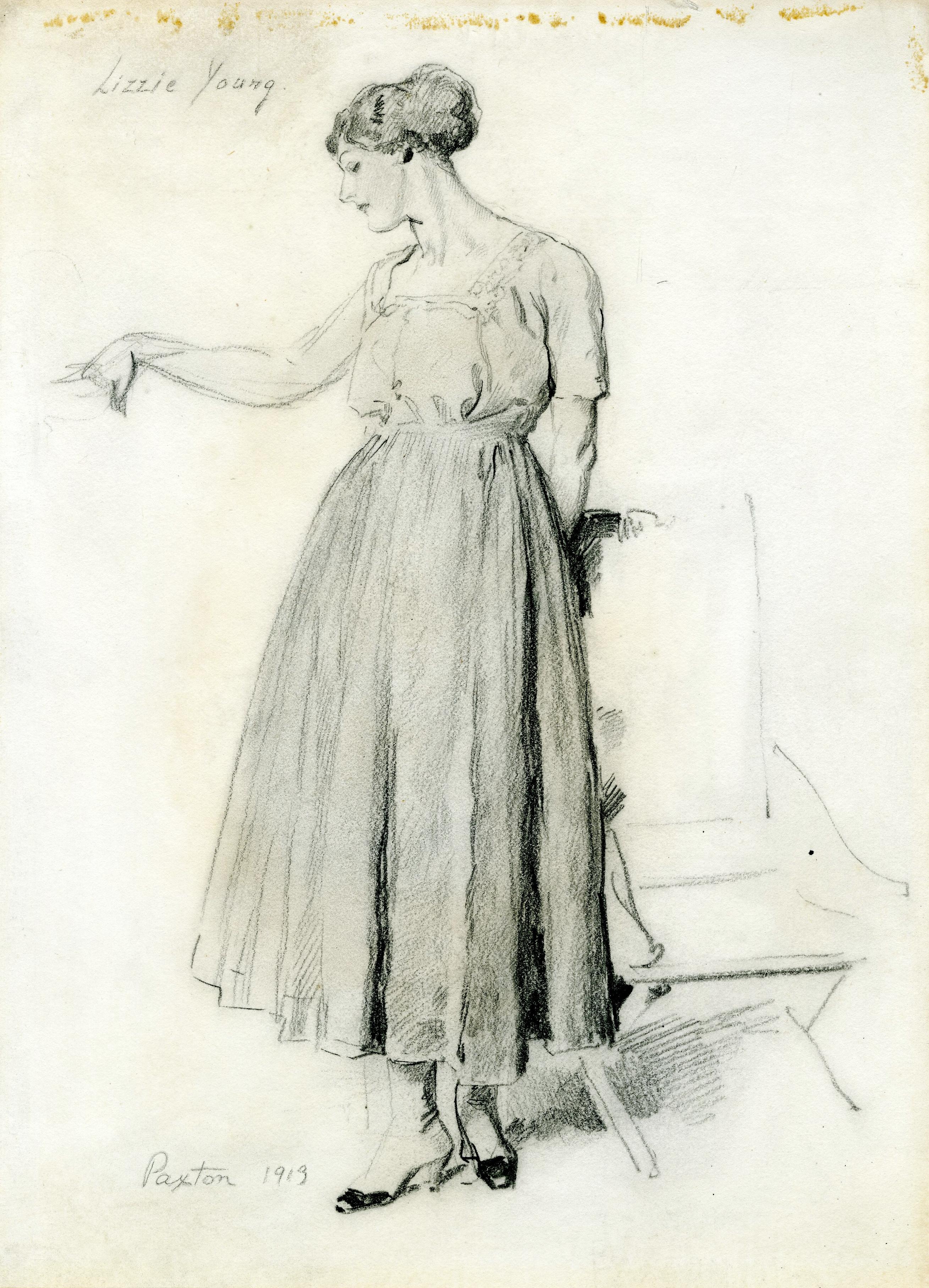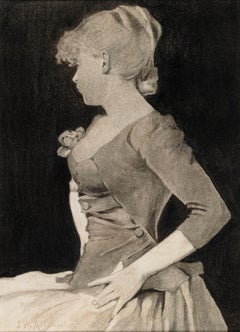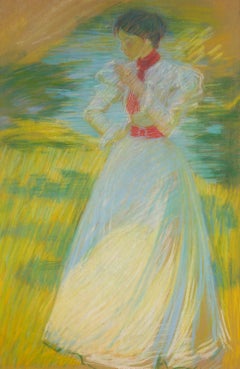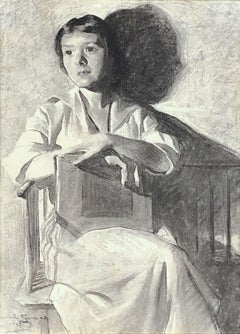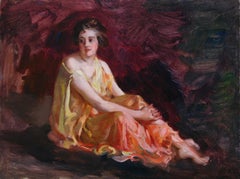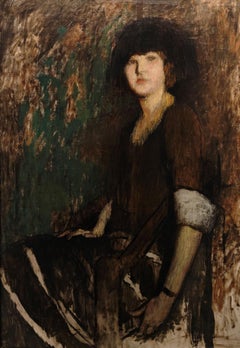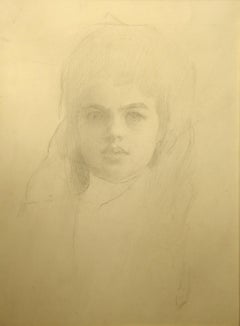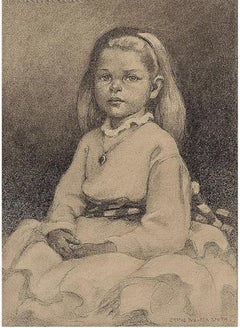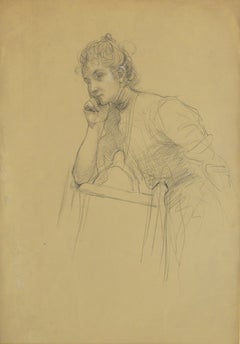Items Similar to Study of Ruth
Want more images or videos?
Request additional images or videos from the seller
1 of 7
Lilian Westcott HaleStudy of Ruthc. 1925
c. 1925
$75,000
£56,758.79
€65,190.47
CA$106,653.62
A$115,634.49
CHF 60,939.14
MX$1,406,228.28
NOK 758,179.64
SEK 716,983.70
DKK 486,683.44
About the Item
Study of Ruth, c. 1925
Charcoal and sepia ink on paper
22 1/4 x 27 3/4 inches (56.5 x 70.5 cm)
Signed upper center: Lillian Westcott Hale
Lilian Westcott Hale showed an exceptional talent for and dedication to art from a very early age. She first began studying at the Hartford Art School in Connecticut where she caught the eye of the important teacher and Impressionist painter, William Merritt Chase. Hale went on to attend his summer school at Shinnecock, and indeed, Chase was so impressed with the young student that he was “afraid to interfere with what she was doing.”28 In 1900, she won a scholarship to begin studying at the Museum School in Boston. Her instructors included Edmund C. Tarbell and Philip Leslie Hale, whom she fell in love with and married in 1902.
The choice to marry Philip was not an easy one, particularly at a time when so many women artists believed that for “the vast majority of women it is impossible to practice art after marriage.”29 As Hale carefully weighed the decision, her sister encouraged her, saying: “Mr. Hale seems a man very congenial in his tastes to yours, and I do not see why [by] loving and marrying him you would break your vow of everlasting faithfulness to your work.”30 While she ultimately accepted his proposal and the marriage was a happy one, it was not without its complications. Philip was very supportive of Hale’s painting career, but as her talent quickly outshone his and her work became more successful, tensions arose; she sought to dispel them by overcompensating in her deference towards her husband, addressing him in a way that still “suggested the relationship of master and pupil.”31 In 1908, their daughter Nancy was born, and Hale became increasingly occupied with the responsibilities of motherhood. She moved her studio out of the Fenway Studio Building and into their home. Nevertheless, she managed to balance her maternal duties with her art; her daughter became one of her primary subjects, which enabled her to both mind her child and produce work at the same time.
Hale painted portraits, figure studies, still lifes, and landscapes; moreover, she also produced finished charcoal drawings which she often displayed alongside her paintings and considered them to be of equal importance. She developed a sensitive and delicate style, and her drawings are especially extraordinary in that regard. As one contemporary reviewer remarked, “But in her drawing, it is safe to say that she is without a rival. The delicacy of her black and white is indescribable; the whiteness of the white, and the paleness of the gray are notable always, but the subtlety of the two as they become one, tests the eye of the average observer.”32 Her drawing technique is also particularly singular—the subtle modulation of tone is created by parallel vertical lines, layered with varying density, which contrast with the white of the untouched paper.
- Creator:Lilian Westcott Hale (1881 - 1963, American)
- Creation Year:c. 1925
- Dimensions:Height: 22.25 in (56.52 cm)Width: 27.75 in (70.49 cm)
- Medium:
- Movement & Style:
- Period:
- Condition:
- Gallery Location:Bryn Mawr, PA
- Reference Number:1stDibs: LU2773216777752
About the Seller
5.0
Recognized Seller
These prestigious sellers are industry leaders and represent the highest echelon for item quality and design.
Platinum Seller
Premium sellers with a 4.7+ rating and 24-hour response times
Established in 2001
1stDibs seller since 2024
6 sales on 1stDibs
- ShippingRetrieving quote...Shipping from: Bryn Mawr, PA
- Return Policy
Authenticity Guarantee
In the unlikely event there’s an issue with an item’s authenticity, contact us within 1 year for a full refund. DetailsMoney-Back Guarantee
If your item is not as described, is damaged in transit, or does not arrive, contact us within 7 days for a full refund. Details24-Hour Cancellation
You have a 24-hour grace period in which to reconsider your purchase, with no questions asked.Vetted Professional Sellers
Our world-class sellers must adhere to strict standards for service and quality, maintaining the integrity of our listings.Price-Match Guarantee
If you find that a seller listed the same item for a lower price elsewhere, we’ll match it.Trusted Global Delivery
Our best-in-class carrier network provides specialized shipping options worldwide, including custom delivery.More From This Seller
View AllSilhouette of a Young Girl
By John White Alexander
Located in Bryn Mawr, PA
Silhouette of a Young Girl
Charcoal on paper
14 1/2 x 10 3/4 inches (36.8 x 27.3 cm)
Signed lower left: J.W. Alexander
Provenance
Grand Central Art Galleries, New York;
Samuel B. an...
Category
Late 19th Century Aesthetic Movement Figurative Drawings and Watercolors
Materials
Paper, Charcoal
Woman with Red Sash
By Philip Leslie Hale
Located in Bryn Mawr, PA
An influential critic, writer and teacher, Philip Leslie Hale was an American Impressionist with an experimental, avant-garde approach to painting. Born in Boston, Massachusetts, the son of author Edward Everett Hale and the younger brother of artist Ellen Day Hale, Philip was raised in a lively intellectual atmosphere. He probably received his first artistic training from his paternal aunt Susan Hale, after which he entered the Boston Museum of Fine Arts School under Edmund Tarbell, an American Impressionist painter who greatly influenced Hale’s style. A year later in 1884, the young artist moved to New York City, where he enrolled at the Art Students League and studied under Kenyon Cox and J. Alden Weir. There, his fellow students included Theodore Butler and William Howard “Peggy” Hart.
In 1887, Hale traveled to Paris with Theodore Butler and Susan Hale, where he furthered his artistic training at Ecole des Beaux-Arts and Académie Julian. During this first year, he studied with Jules-Joseph Lefebvre, Gustave Boulanger and Henri Lucien Doucet...
Category
1890s Abstract Impressionist Figurative Drawings and Watercolors
Materials
Pastel
Elsa
By Daniel Garber
Located in Bryn Mawr, PA
Elsa, 1915
Charcoal on paper, 14 x 11 inches (35.6 x 27.9 cm)
Signed and dated lower left: Daniel Garber / 1915
Provenance
The artist;
Estate of the artist, 1958;
Tanis Garber Page,...
Category
Early 20th Century Figurative Drawings and Watercolors
Materials
Charcoal
$14,500
Dance Interlude, c. 1910-20
Located in Bryn Mawr, PA
Oil on board
Provenance
Estate of Marjorie MacMonnies Wysong (the artist's granddaughter); Hap Moore Auctions; Martin Ferrick Antiques
Exhibitions
Avery Galleries, Bryn Mawr, Pennsylvania, American Women Artists: 1860–1960, October 13–November 10, 2017.
Description
During her expatriate career, between the mid-1880s and return to the United States in 1920, painter and muralist Mary Fairchild MacMonnies (later Low) was one of the most successful American women artists of her generation. Mary Fairchild was born in Connecticut, but was raised largely in St. Louis, Missouri. Inspired by her mother's work as a painter of miniatures and dissatisfied as a school teacher, she enrolled in the St. Louis School of Fine Arts, where she led a movement for women to be permitted to draw model posed in the nude, an important component of artistic training then considered improper for well-bred young women. Impressed by her talent and drive, the school's director, Halsey Ives...
Category
1910s American Impressionist Portrait Paintings
Materials
Oil
In Venice
By Charles Webster Hawthorne
Located in Bryn Mawr, PA
Like his mentor the great American Impressionist William Merritt Chase, Charles Webster Hawthorne was equally admired in his own day as both a talented painter and a highly influential instructor. Hawthorne first studied with Chase at his Shinnecock Summer School of Art, which was specifically dedicated to open-air landscape painting. Not only did Hawthorne quickly absorb all the principles of Chase’s instruction, but he also became determined to found his own school based on the same model. In 1899 Hawthorne discovered the small fishing village of Provincetown on the furthermost tip of Cape Cod, and after purchasing a large house on Miller Hill, he opened the Cape Cod School of Art, which proved to be an immediate success.
While Hawthorne’s own approach as a teacher owed much to Chase, he developed a distinctly unique painting style and teaching method that defies easy categorization. He was greatly impressed with the work of Franz Hals, which he was exposed to during his trip to Holland in the summer of 1898. Hawthorne was particularly struck by Hals’ Regentesses of the Old Men’s Almhouse, and from this work he absorbed a deep appreciation for the power of human expression and an economy of technique. Hawthorne applied these lessons to his own realistic portraits of Provincetown fishermen and their families; these works have a somber, almost melancholy quality to them, and they reveal a sense of the vulnerability of the human condition.
Stylistically, Hawthorne maintained a life-long commitment to the importance of color. “Beauty in art,” he said, “is the delicious notes of color one against the other.” Of equal importance to him was capturing the effects of light. He told his students: “Everything in painting is a matter of silhouettes. Hold light against shadow, not light against light.” He developed a particular technique of layering glazes and texturing the surface of his paintings, which heightens the relationship between the colors and creates a light effect that seems to emanate from within the painting. These stylistic techniques in combination with his straightforward compositions of one or more figures shown at close range create the hallmarks of Hawthorne’s best paintings.
Hawthorne and his wife Ethel’s 1905-1907 trip to Italy did not result in a drastic impact on his artistic style. Nonetheless, it proved to be a transformative and enlightening voyage. The extensive trip was financed by collectors who paid in advance for a painting to be produced abroad. On the trip, Hawthorne explored the work of old masters and was struck particularly by the paintings of Titian, which to Hawthorne, demonstrated the master’s true adoration for the act of painting itself through his handling of paint and color. Where Titian’s paintings...
Category
Early 1900s Abstract Impressionist Figurative Paintings
Materials
Oil, Panel
Study for "Golden Fall"
By Joseph Stella
Located in Bryn Mawr, PA
Study for "Golden Fall", 1940
Pastel on paper, 26 x 20 inches (66 x 50.8 cm)
Framed dimensions 33 1/2 x 27 1/2 inches
Joseph Stella’s artistic career defies easy categorization. He ...
Category
20th Century American Modern Figurative Drawings and Watercolors
Materials
Paper, Pastel
You May Also Like
"Portrait of a Lady (Study for Harriet Blake)" Lilian Westcott Hale, Painting
By Lilian Westcott Hale
Located in New York, NY
Lilian Westcott Hale
Portrait of a Lady (Study for Harriet Blake)
Oil on canvas
40 ¼ x 30 ¼ inches
A leading American Impressionist working at t...
Category
1920s Impressionist Figurative Paintings
Materials
Canvas, Oil
"Portrait of a Girl, " attrib. to Edmund Tarbell, graphite, portrait, 1900-1910
Located in Wiscasset, ME
Born in Groton, Massachusetts in 1862, impressionist painter Edmund Charles Tarbell studied with George H. Bartlett at the Massachusetts Normal Art School, under Otto Grundmann at the School of the Museum of Fine Arts in Boston and in 1883, entered the Académie Julian to study under Gustave Boulanger and Jules Joseph Lefebvre. In 1884, his education included a Grand Tour to Italy and the following year to Belgium, Germany and Brittany.
Tarbell returned to Boston in 1886 where he began his career as an illustrator, private art instructor and portrait painter. He was a member of the Ten American Painters and was a leading member of a group of painters which came to be known as the Boston School.
In 1889 Tarbell assumed the position of his former mentor, Otto Grundmann, at the Museum School. His students included Bertha Coolidge, Margaret Fitzhugh Browne...
Category
Early 1900s Impressionist Portrait Drawings and Watercolors
Materials
Graphite
Portrait of Seated Girl
By Jessie Willcox Smith
Located in Fort Washington, PA
Medium: Charcoal on Paper
Signature: Signed Lower Right
Category
20th Century Portrait Drawings and Watercolors
Materials
Paper, Charcoal
Pensive Young Woman
By Maurice Chabas
Located in Paris, Île-de-France
Maurice Chabas (Nantes 1862 – Versailles 1947)
Pensive Young Woman
Graphite with white-chalk highlights on blue-grey paper
46 × 32 cm
Unsigned
Provenance
Bruno Delarue Gallery, É...
Category
1890s Impressionist Portrait Drawings and Watercolors
Materials
Pencil, Chalk
Portrait of a resting young lady (Marjorie Organ)
By Robert Henri
Located in Fairlawn, OH
Portrait of a resting young lady (Marjorie Organ)
Black chalk on paper. c. 1907
signed in ink by Henri's nephew, John C. LeClair, the executor of the Henri estate
"Robert Henri JLC"
Note: The sitter for this portrait is depicted in two drawings of similar size, illustrated in Chapellier Galleries Inc., Robert Henri 1865-1929, 1976, nos. 15 & 16.
Please see the attached photo of Marjorie Organ, Henri's second wife
Condition: Excellent
Image/Sheet size: 10 3/8 x 7 1/2 inches
Provenance: Estate of the Artist
John C. LeClair, Estate Adminitrator
Private Collection, Pawling, New York
Biography
Robert Henri was born Robert Henry Cozad in Cincinnati, Ohio, on June 24, 1865, the son of a professional gambler and real estate developer. The family lived in Nebraska and Colorado, but fled east when the father shot and killed a rancher over a land dispute and was indicted for manslaughter. They changed their last name because of the ensuing scandal and eventually settled in Atlantic City, New Jersey, during the early 1880s.
In 1886 Henri enrolled at the Pennsylvania Academy of the Fine Arts in Philadelphia, where he studied under Thomas Anshutz, Thomas Hovenden...
Category
Early 1900s American Impressionist Figurative Drawings and Watercolors
Materials
Graphite
Preliminary Study for the painting Rose and Gold, 1913
By William McGregor Paxton
Located in Fairlawn, OH
Preliminary Study for the painting Rose and Gold, 1913
Graphite on paper, 1913
Signed in pencil lower left (see photo)
Titlted "Lizzy Young" in pencil upper left (see photo)
Lizzy was a modle that Paxton depicts numerous times.
The painting that this drawing is related to, is illustrated in Lee & Krause, William McGregor Paxton, 1869-1941, Plate 32, text on page 132. The painting was formerly in the collection of Victor Spark and the Honorable Paul Buchanan. It is currently in a Texas Collection.
Provenance: Private Collection, Florida
William McGregor Paxton (June 22, 1869 – 1941) was an American painter and instructor who embraced the Boston School paradigm and was a co-founder of The Guild of Boston Artists. He taught briefly while a student at Cowles Art School, where he met his wife Elizabeth Okie Paxton, and at the Museum of Fine Arts School in Boston. Paxton is known for his portraits, including those of two presidents—Grover Cleveland and Calvin Coolidge—and interior scenes with women, including his wife. His works are in many museums in the United States.
Early life
He was born on June 22, 1869, in Baltimore to James and Rose Doherty Paxton. William's father moved the Paxton family and established a catering business in Newton Corner, Massachusetts, in the mid-1870s.
Education
Paxton attended Cowles Art School on a scholarship he attained at the age of 18. He studied with Dennis Miller Bunker...
Category
1910s American Impressionist Figurative Drawings and Watercolors
Materials
Graphite
